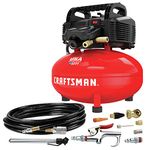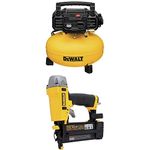10 bestPancake Air Compressorsof December 2025
112M consumers helped this year.
12% off
1

Metabo HPT Air Compressor | The Tank™ | 200 PSI | 6 Gallon | Pancake | EC914SM
Metabo HPT

9.8
2
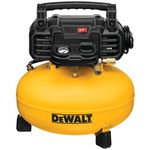
DEWALT Pancake Air Compressor, 6 Gallon, 165 PSI (DWFP55126)
DEWALT

9.6
3

DEWALT DWFP1KIT 18 Gauge Brad Nailer and 6 Gallon Oil-Free Pancake Air Compressor Combo Kit
DEWALT

9.3
4

Makita Mac700 2.0 Hp Big Bore Air Compressor
Makita

9.0
5
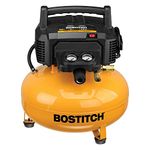
BOSTITCH Pancake Air Compressor, Oil-Free, 6 Gallon, 150 PSI (BTFP02012)
Bostitch

8.7
Other
6
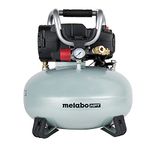
Metabo HPT Pancake Air Compressor, 6 Gallon (EC710S)
Metabo HPT

8.5
7

PORTER-CABLE Air Compressor, 6-Gallon, Pancake, Oil-Free (C2002)
PORTER-CABLE

8.2
8
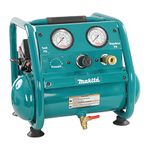
Makita AC001 Compact Air Compressor
Makita

7.9
9
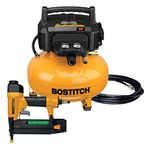
BOSTITCH 18 Guage Brad Nailer & Compressor Combo Kit, Oil Free, Easy Start (BTFP1KIT-CA)
Bostitch

7.6
10
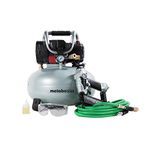
Metabo HPT CA Tools KNT50AB Brad Nailer & Portable Air Compressor Combo Kit, 6-Gallon Oil-Free Pancake Air Compressor, NT50AE2 18-Gauge Brad Nailer, Includes 25 ft x 1/4-Inch Hybrid Air Hose
Metabo HPT

7.3
A Guide to Selecting the Best Pancake Air Compressors
Choosing the right pancake air compressor can make your DIY projects, home repairs, or hobby work much easier and more efficient. Pancake air compressors are popular because they are compact, portable, and easy to store, making them ideal for small workshops, garages, or even for taking to job sites. When picking the best one for your needs, it's important to understand the key specifications and how they relate to the tasks you want to accomplish. By focusing on the main features, you can ensure you get a compressor that matches your requirements and will serve you well for years.
Tank Capacity (Gallons)
Tank capacity refers to how much compressed air the tank can hold, usually measured in gallons. This is important because a larger tank can store more air, allowing you to use your tools for longer periods before the compressor needs to refill. Pancake compressors typically range from 1 to 6 gallons. Smaller tanks (1-3 gallons) are lighter and easier to carry, making them suitable for quick jobs like inflating tires or brad nailing. Larger tanks (4-6 gallons) can handle more demanding tasks like framing or running multiple tools for longer stretches. To pick the right size, think about how long and how often you'll need continuous air—if you only need short bursts, a smaller tank is fine, but for longer or more frequent use, go bigger.
Maximum PSI (Pounds per Square Inch)
PSI measures the maximum air pressure the compressor can deliver. This is important because different tools require different pressures to operate properly. Most pancake compressors offer between 90 and 150 PSI. Lower PSI (around 90) is enough for basic tasks like inflating or stapling, while higher PSI (120-150) is better for more demanding tools like impact wrenches or paint sprayers. Check the requirements of the tools you plan to use and make sure the compressor can meet or exceed those needs.
CFM (Cubic Feet per Minute)
CFM tells you how much air the compressor can deliver at a certain pressure, which is crucial for running air tools efficiently. Higher CFM means the compressor can power more demanding tools or run multiple tools at once. Pancake compressors usually provide between 1 and 3 CFM at 90 PSI. For light tasks like brad nailing or inflating, lower CFM is sufficient. For tools that need a steady flow of air, like sanders or spray guns, look for higher CFM ratings. Match the CFM rating to the requirements of your most demanding tool.
Portability and Weight
Portability is about how easy it is to move and store the compressor. Pancake compressors are designed to be portable, but their weight can vary. Lighter models (under 30 pounds) are easier to carry around, which is great if you need to move the compressor frequently. Heavier models may offer more power or capacity but can be harder to transport. Consider how often you'll need to move the compressor and choose a weight that fits your lifestyle.
Noise Level
Noise level is measured in decibels (dB) and tells you how loud the compressor will be when running. This is important if you'll be using the compressor indoors or in noise-sensitive environments. Pancake compressors can range from about 60 dB (quieter) to over 80 dB (louder). If you value a quieter workspace or will be using the compressor in a shared space, look for models with lower noise ratings.
Oil-Free vs. Oil-Lubricated
This refers to how the compressor's pump is maintained. Oil-free compressors require less maintenance and are cleaner, making them ideal for home use and occasional projects. Oil-lubricated compressors may last longer and run more quietly, but they need regular oil changes and can be messier. For most home users, oil-free is the more convenient choice, but if you plan to use the compressor heavily, consider oil-lubricated options.
Best Reviews Guide Newsletter
Get exclusive articles, recommendations, shopping tips, and sales alerts
Sign up for our newsletter to receive weekly recommendations about seasonal and trendy products
Thank you for subscribing!
By submitting your email address you agree to our Terms and Conditions and Privacy Policy

